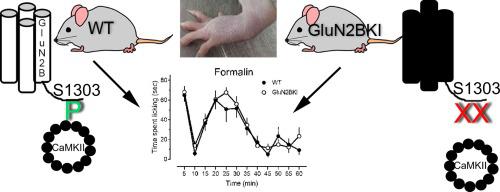Brain Research ( IF 2.9 ) Pub Date : 2020-10-14 , DOI: 10.1016/j.brainres.2020.147154 Uche P Maduka 1 , Stephanie R White 2 , Mei-Ling A Joiner 2 , Johannes W Hell 3 , Donna L Hammond 4

|
Activation of Ca2+/calmodulin kinase II (CaMKII) and the N-Methyl D-aspartate receptor (NMDAR), particularly its GluN2B subunit, contribute to the central sensitization of nociceptive pathways and persistent pain. Using mutant mice wherein the activity-driven binding of CaMKII to S1303 in GluN2B is abrogated (GluN2BKI), this study investigated the importance of this interaction for acute and persistent inflammatory nociception. GluN2BKI, wild type and heterozygote mice did not differ in responses to acute noxious heat stimuli as measured with tail flick, paw flick, or hot plate assays, nor did they differ in their responses to mechanical stimulation with von Frey filaments. Surprisingly, the three genotypes exhibited similar spontaneous pain behaviors and hypersensitivity to heat or mechanical stimuli induced by intraplantar injection of capsaicin; however, GluN2BKI mice did not immediately attend to the paw. WT and GluN2BKI mice also did not differ in the nociceptive behaviors elicited by intraplantar injection of formalin, even though MK801 greatly reduced these behaviors in both genotypes concordant with NMDAR dependence. CaMKII binding to GluN2B at S1303 therefore does not appear to be critical for the development of inflammatory nociception. Finally, intrathecal KN93 reduced formalin-induced nociceptive behaviors in GluN2BKI mice. KN93 does not inhibit CaKMII, but rather binds Ca2+/calmodulin. It has multiple other targets including Ca2+-, Na+- and K+-channels, as well as various kinases. Therefore, the use of GluN2BKI mice provided genetic specificity in assessing the role of CaMKII in inflammatory pain signaling cascades. These results challenge current thinking on the involvement of the CaMKII-NMDAR interaction in inflammatory pain.
中文翻译:

CaMKII 在 S1303 与 GluN2B 结合对急性或炎性疼痛没有作用
Ca 2+ 的活化/钙调蛋白激酶 II (CaMKII) 和 N-甲基 D-天冬氨酸受体 (NMDAR),特别是其 GluN2B 亚基,有助于伤害感受通路和持续性疼痛的中枢敏化。使用其中 CaMKII 与 GluN2B 中 S1303 的活性驱动结合被废除 (GluN2BKI) 的突变小鼠,本研究调查了这种相互作用对急性和持续性炎症伤害感受的重要性。GluN2BKI、野生型和杂合子小鼠在对急性有害热刺激的反应方面没有差异,如用甩尾、甩爪或热板测定法测量的,它们对 von Frey 细丝机械刺激的反应也没有差异。令人惊讶的是,三种基因型表现出相似的自发性疼痛行为和对足底注射辣椒素诱导的热或机械刺激的超敏反应;然而,GluN2BKI 小鼠没有立即注意爪子。WT 和 GluN2BKI 小鼠在足底注射福尔马林引起的伤害性行为方面也没有差异,尽管 MK801 在与 NMDAR 依赖性一致的两种基因型中大大减少了这些行为。因此,CaMKII 在 S1303 与 GluN2B 的结合对于炎症性伤害感受的发展似乎不是关键。最后,鞘内注射 KN93 减少了福尔马林诱导的 GluN2BKI 小鼠的伤害性行为。KN93 不抑制 CaKMII,而是结合 Ca 因此,CaMKII 在 S1303 与 GluN2B 的结合对于炎症性伤害感受的发展似乎不是关键。最后,鞘内注射 KN93 减少了福尔马林诱导的 GluN2BKI 小鼠的伤害性行为。KN93 不抑制 CaKMII,而是结合 Ca 因此,CaMKII 在 S1303 与 GluN2B 的结合对于炎症性伤害感受的发展似乎不是关键。最后,鞘内注射 KN93 减少了福尔马林诱导的 GluN2BKI 小鼠的伤害性行为。KN93 不抑制 CaKMII,而是结合 Ca2+ /钙调蛋白。它有多个其他目标,包括 Ca 2+ -、Na + - 和 K + -通道,以及各种激酶。因此,使用 GluN2BKI 小鼠提供了评估 CaMKII 在炎症性疼痛信号级联反应中的作用的遗传特异性。这些结果挑战了当前关于 CaMKII-NMDAR 相互作用参与炎症性疼痛的想法。



























 京公网安备 11010802027423号
京公网安备 11010802027423号